Physical Address
304 North Cardinal St.
Dorchester Center, MA 02124
The biliary tract is lined by simple columnar epithelial cells of foregut origin ( Fig. 47.1 ). The vast majority of biliary neoplasms arise from this cell type and therefore show major similarities to other foregut tumors, particularly those of pancreatic ductal origin (see Chapter 1 ). By far the most common neoplasm of the biliary tract is adenocarcinoma, referred to collectively with pancreatic ductal adenocarcinoma as a pancreatobiliary-type adenocarcinoma ( Figs. 47.2–47.5 ), reflecting the similarities between these two neoplasms (see Chapter 59 ).
Tumors arising from the gallbladder and the different segments of the bile ducts have overlapping histologic characteristics; therefore their pathologic classification is also very similar. On the other hand, the risk factors, clinical findings, and biologic behavior may vary (see Chapters 49 , 50 , 51 , and 59 ). For example, although gallstones are the main risk factor for gallbladder adenocarcinoma, adenocarcinomas of the proximal bile ducts have a much stronger association with primary sclerosing cholangitis (PSC; see Chapter 41 ) or anomalous pancreatobiliary duct junction. This variability also is partially reflected in the molecular alterations, which, although not specific for the histologic subtype of the tumor, may affect the management and prognosis (see Chapter 9E ). The different presentations of biliary adenocarcinoma also influence the mode by which a specimen is obtained for pathologic examination. For example, many gallbladder adenocarcinomas are currently identified in “routine” cholecystectomy specimens from primary care facilities, performed with a preoperative diagnosis of chronic cholecystitis or symptomatic cholelithiasis, whereas extrahepatic bile duct lesions are seldom resected without a strong preoperative suspicion of carcinoma, and this is usually performed in tertiary care facilities.
This chapter discusses the pathologic aspects of biliary tract neoplasia, with special emphasis on adenocarcinomas. The tumor types are discussed by viewing the biliary system as a whole; site-specific characteristics are mentioned only when pertinent to pathologic classification. For the details of clinical findings, risk factors, and site-specific management, the reader is referred to other chapters.
Most “biliary tract cancers” are conventional adenocarcinomas (pancreatobiliary-type), which are morphologically very similar to pancreatic ductal adenocarcinoma. This tumor is referred to as intrahepatic cholangiocarcinoma in the intrahepatic biliary tract (see Chapter 50 ) and adenocarcinoma in the extrahepatic biliary tract (see Chapters 51 and 59 ) and in the gallbladder (see Chapter 49 ). As in adenocarcinomas of other organs, these are usually tumors of elderly persons. The association of biliary adenocarcinomas with preceding chronic inflammation has been well established, , mostly by epidemiologic data showing the high incidence of gallbladder cancer in areas with a high prevalence of gallstones and by the pathologic observation that many individual carcinomas have associated gallstones or cholecystitis (see Chapter 49 ). Also, the risk of adenocarcinoma is relatively high in patients with PSC (see Chapter 41 ) and indirectly in those with ulcerative colitis. The association of biliary cancers with some infectious agents, especially Salmonella serovar Typhi and parasites (e.g., Clonorchis sinensis ), , as well as with choledochal cysts (see Chapter 46 ), is also presumably related to the potential for chronic inflammation from constant epithelial injury and repair that can lead to neoplastic alterations. The role of Helicobacter spp., especially Helicobacter bilis , has been studied in gallbladder cancers. ,
Based on their macroscopic growth pattern, biliary carcinomas have been divided into four types: (1) polypoid, (2) nodular (nodular-sclerosing), (3) scirrhous-constricting, and (4) diffusely infiltrative. , Polypoid growth typically is found in carcinomas, with an associated component of intraductal papillary or tubulopapillary neoplasms, previously designated noninvasive papillary carcinoma, which are associated with a better prognosis. The nodular and scirrhous-constricting types have a propensity to infiltrate surrounding tissues and are therefore difficult to resect. The scirrhous-constricting and diffusely infiltrative patterns may be difficult to differentiate from chronic inflammatory conditions, especially PSC and autoimmune cholangitis. The diffusely infiltrating type tends to spread linearly along the ducts. Significant histologic overlaps occur among these different growth patterns, so their utility in pathologic tumor classification is limited.
On cut sections, the intraluminal components of biliary carcinomas, especially those with a polypoid gross appearance, may appear more friable, soft, and tan. This reflects the presence of intraductal neoplastic elements growing into the lumen, and ulceration and necrosis may be evident in larger tumors; so much so that the tumor may appear to represent “debris” in the lumen. The infiltrating components of adenocarcinomas are more scirrhous (scar-like), with a firm, white, gritty appearance because of the abundance of desmoplasia, the fibrotic tissue reaction associated with infiltrating carcinoma (see Fig. 47.2 ).
When adenocarcinoma invades the adjacent liver, the growth pattern often becomes more expansile, and the liver-carcinoma interface appears deceptively well demarcated. This allows for easier detection of the boundaries of these carcinomas in hepatic resections. In contrast, the boundaries of carcinomas invading the hilar soft tissue are typically poorly defined and difficult to appreciate. In the literature, porcelain gallbladder , which had been defined as extensive calcification in the gallbladder wall, has been reported to have a particularly strong association with carcinoma, but recent studies have shown that a distinctive type of hyalinizing cholecystitis with minimal or no calcifications (incomplete porcelain gallbladder) actually has the higher risk for carcinoma.
Most adenocarcinomas of the gallbladder and bile ducts show the characteristic features of a pancreatobiliary-type adenocarcinoma (see Figs. 47.3–47.5 ): both simple and complex, irregularly shaped glands mixed with small clusters of cells, often with associated stromal desmoplasia. , , The glands often are well formed, lined by cuboidal cells, and show dilated lumina. The nuclear grade may be unexpectedly high for the degree of glandular differentiation, and marked variation in nuclear size, shape, and intracellular location may occur between different cells within the individual glands. The cytoplasm may be acidophilic and granular in some cases and pale or clear in others. Variable amounts of intracytoplasmic and intraluminal mucin are present; in some cases, mucin is readily evident by routine histologic examination; in others, it is only demonstrable by histochemical stains.
Perineural invasion (see Fig. 47.4 ) and vascular invasion are common, and carcinoma cells, when they invade these structures, may have a deceptively well-differentiated appearance. In fact, the distinction of a well-differentiated adenocarcinoma from a benign reactive process in this region is one of the more challenging differential diagnoses in surgical pathology.
Dysplasia, or biliary intraepithelial neoplasia (BilIN; Fig. 47.6 ), is often present in the adjacent biliary epithelium. Sometimes the intraepithelial component includes a papillary neoplasm ( Fig. 47.7 ). In such cases, the noninvasive and invasive components of the tumor should be evaluated separately, and the extent of invasion should be quantified because those with “minimal invasion” have been shown to have a relatively favorable outcome. In contrast, widely invasive cases typically have an aggressive clinical course. Even in the absence of invasive carcinoma, these tumors may recur and metastasize, possibly because of the presence of an undetected focus of invasive carcinoma, or a “field-effect” phenomenon that predisposes the remaining segments of biliary tract to the development of carcinoma.
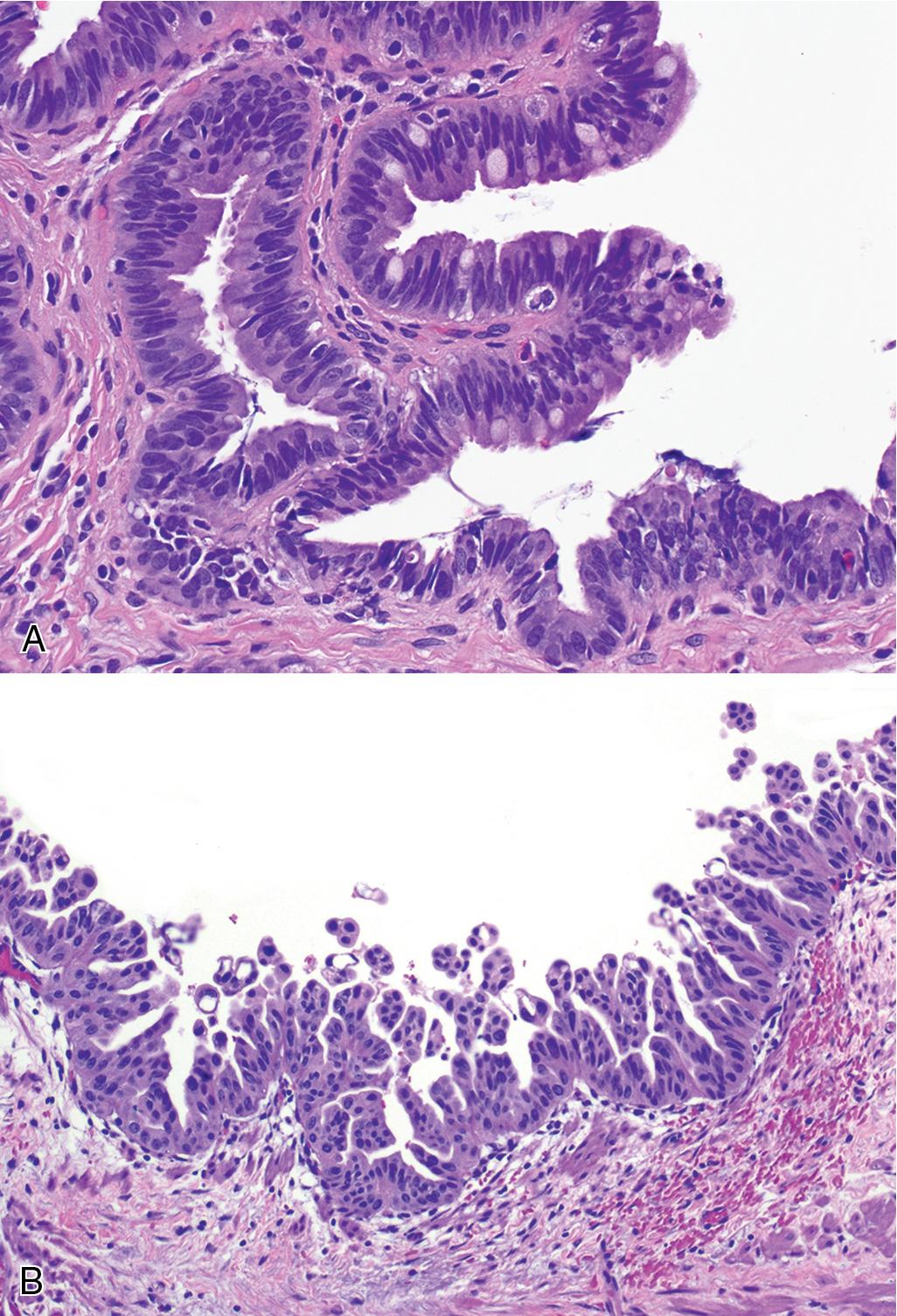
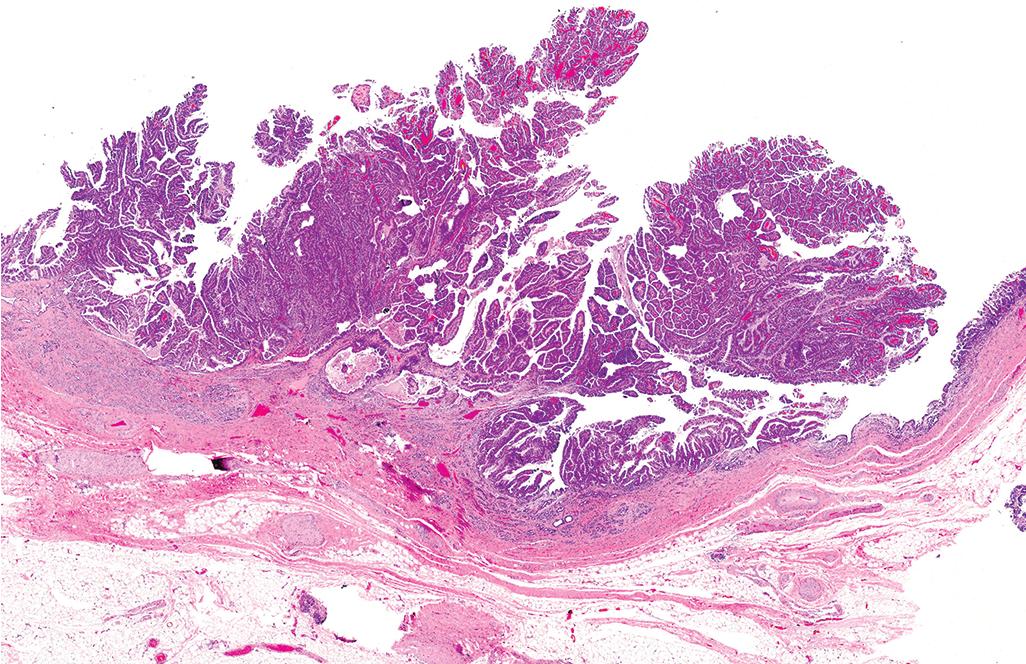
Tumors that infiltrate the adjacent liver may acquire a more trabecular pattern, presumably by growing along the sinusoidal backbone of the liver parenchyma. Entrapped reactive bile ductules and hepatocytes are often present within the tumor and may create a diagnostic problem in biopsy specimens.
For therapeutic and prognostic purposes, tumors of the extrahepatic biliary tract are traditionally separated by their anatomic distribution into peri-hilar (arising predominantly in the main lobar extrahepatic ducts, distal to segmental bile ducts and proximal to the cystic duct), mid-duct, and distal (located between the confluence of the common hepatic duct and cystic duct and Ampulla of Vater, excluding ampullary carcinoma; see Chapter 2 ). Mid-duct carcinomas, however, do not include a separate site for staging. The distinctive clinical characteristics of adenocarcinomas that occur in different segments of the biliary tract are discussed in other chapters, and only a few issues pertinent to pathologic aspects are mentioned here. Most extrahepatic biliary tract carcinomas are peri-hilar and tend to be the scirrhous-constricting and diffusely infiltrative types. Studies have shown that many originate within 5 mm of the cystic duct junction or within the cystic duct itself. Hilar carcinoma, located at the confluence of the right and left hepatic ducts, sometimes referred to as a Klatskin tumor, , has distinctive clinical features. Klatskin tumors usually grow into the liver rather than distally toward the duodenum, and the component that invades the liver is often well demarcated. Carcinomas in the middle third tend to be the nodular sclerosing type (thickened along a long segment, with a narrow lumen and inflammatory changes in the surrounding tissues) and thus are difficult to differentiate from extrahepatic sclerosing cholangitis. These have a very high propensity for perineural invasion and involvement of radial surfaces, making curative resection difficult. Carcinomas in the distal common bile duct (CBD) have the best prognosis because of their resectability by pancreatoduodenectomy and because many, especially those close to the ampullary region, are composed predominantly of noninvasive neoplastic elements.
The difficulty at the clinical level of distinguishing biliary adenocarcinomas from benign inflammatory conditions, such as sclerosing cholangitis, is also problematic at the microscopic level. Reactive changes in the accessory biliary ductules in the wall of the bile ducts can mimic adenocarcinomas, although nonneoplastic ductules may retain a lobular configuration, and they lack the density of cellularity of a carcinoma. Pancreatobiliary adenocarcinomas can be deceptively benign appearing, composed of well-formed glandular elements lined by fairly organized, cytologically bland glandular cells (see Fig. 47.3 ). The distinction of reactive changes in the surface epithelium from dysplasia/BilIN often proves to be even more challenging, especially because any injury to the biliary epithelium, including instrumentation and stent placement, has a tendency to induce marked cytologic atypia that can mimic the appearance of high-grade dysplasia ( Fig. 47.8 ). Marked nuclear enlargement or irregularity, hyperchromasia, loss of polarity, mitotic figures, apoptotic cells, and intraluminal necrosis are findings in favor of a neoplastic process (see Fig. 47.6 ). Overlaps are common, however, and at times this distinction may not be possible on the basis of biopsies or frozen sections.
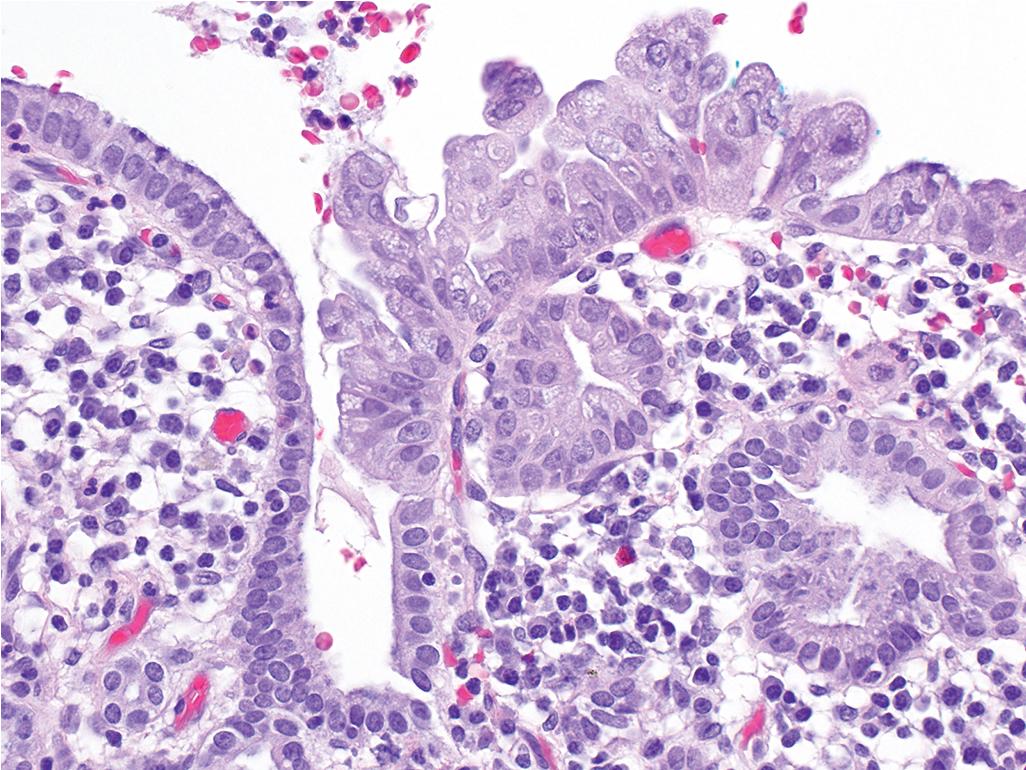
Biliary carcinomas that grow into the liver must be distinguished from primary hepatocellular carcinomas (see Chapter 89 ). The presence of true glandular elements and mucin are common findings in biliary carcinomas and typically are absent in hepatocellular carcinomas. In contrast, hepatocellular carcinomas may have intracellular bile and generally lack significant stromal fibrosis and desmoplasia. Other distinctive features of hepatocellular carcinomas—the solid and trabecular growth pattern, centrally located nuclei with prominent nucleoli, and abundant eosinophilic cytoplasm—usually are identifiable; immunohistochemical demonstration of hepatocellular differentiation with markers such as hepatocyte-1 or arginase-1 can be used in problematic cases.
Differentiation between ampullary and duodenal neoplasms and CBD tumors can be difficult because carcinomas of these sites often infiltrate neighboring structures (see Chapters 59 and 63 ). In such cases, the correct classification of the tumor greatly depends on determining where it is centered, which often can be achieved only by close correlation of the radiographic and macroscopic findings. In addition, any dysplasia or other preinvasive neoplasm may be an important clue to the site of origin. In this complex region, the origin of the tumor (by site) should be evaluated separately from the type of the carcinoma, such as ampullary carcinomas of the pancreatobiliary-type. Intestinal-type carcinomas in this region are more likely to be of either ampullary or duodenal origin. ,
Biliary carcinomas metastatic to other sites may mimic the primary tumors of those organs. In particular, metastases to the ovary often become cystic and are mistaken for primary ovarian mucinous cystic neoplasms, and lung metastases can resemble mucinous pulmonary adenocarcinomas.
By immunohistochemistry, biliary adenocarcinomas typically express CK7, CK19, B72.3, CA19-9, CEA, MUC1 ( Fig. 47.9 ), and MUC5AC. , , , On occasion, these markers can be helpful in distinguishing certain other carcinomas that do not express these markers, such as hepatocellular carcinoma (see Chapter 89 ). None of these markers, however, is specific enough to prove biliary origin for an adenocarcinoma when a metastasis from another organ is under consideration (see Chapter 90, Chapter 91, Chapter 92 ). Biliary adenocarcinomas generally lack expression of CK20 and CDX2, typically found in intestinal adenocarcinomas; TTF-1 and napsin, found in pulmonary primary tumors; and hormone receptors. In situ hybridization for albumin has recently been shown in intrahepatic (peripheral) cholangiocarcinomas and represents a method to distinguish these from metastatic adenocarcinoma, but hilar cholangiocarcinomas and extrahepatic bile duct adenocarcinomas are negative for this marker.
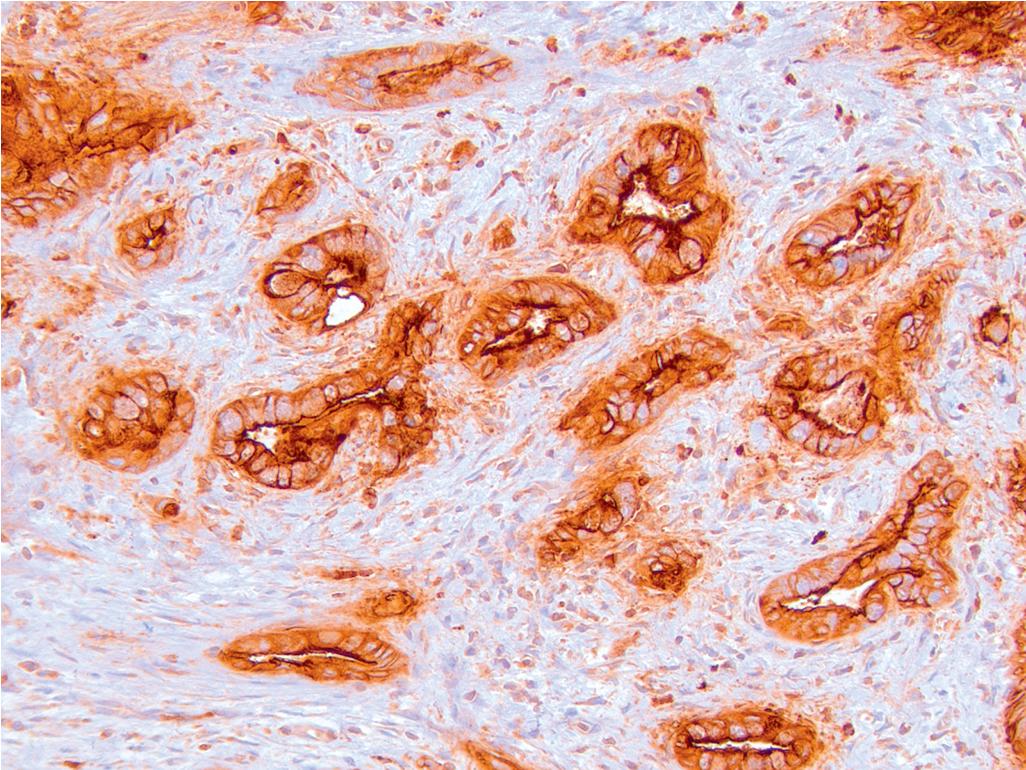
In approximately 65% of cases, positive immunoreactivity for the protein product of the TP53 gene is noted. , Some studies have shown this to be fairly specific for carcinoma, as opposed to the nonneoplastic changes associated with PSC. It should be used cautiously, however, because of significant overlap.
Mutations at codon 12 of the KRAS oncogene, seen in more than 90% of pancreatic ductal adenocarcinomas (see Chapter 9D ), are much less common in biliary adenocarcinomas, and the frequency of KRAS mutation appears to decrease from distal to proximal along the biliary tree. , , Similarly, loss of SMAD4, present in approximately half of pancreatic ductal adenocarcinomas, is almost as common in distal CBD carcinomas. However, SMAD4 is retained in most proximal extrahepatic bile duct carcinomas. More than half of the cases have loss of heterozygosity at 8p, 9q, and 18q; amplification of ERBB2 is also reported in more than half. Overexpression of HER family receptors, including epidermal growth factor receptor (EGFR) and c-met, has also been reported. ,
In gallbladder carcinomas, other common mutations include alterations in CDKN2A or CDKN2B (19%), ARID1A (13%), PIK3CA (10%), and CTNNB1 (10%). , Of these, microsatellite instability and CDKN2A inactivation by promoter methylation, which have been reported in both preinvasive and invasive lesions, may have therapeutic implications in the future. Also, mechanistic target of rapamycin pathway alterations and cyclooxygenase-2 overexpression have been found to be associated with adverse prognosis. ,
Not surprisingly, the adenoma-carcinoma sequence appears to go through different pathways, with paucity of mutations in TP53 and CDKN2A and a higher frequency of mutations in CTNNB1 (encoding β-catenin). A higher KRAS mutation rate in lesions associated with pancreatobiliary maljunction has also been reported. ,
Other, less common carcinomas of glandular epithelial origin in the gallbladder and biliary tract are classified separately from pancreatobiliary-type adenocarcinomas. Intestinal-type adenocarcinomas are morphologically similar to their counterparts in the gastrointestinal (GI) tract. Signet ring cell carcinomas are characterized by a diffusely infiltrative pattern of individual cells, often with signet ring morphology because of intracellular mucin; a cord-like growth pattern may also occur in the biliary tract but is exceedingly uncommon. Mucinous adenocarcinomas may be seen in some cases, with extensive mucin production associated with stromal mucin deposition ( Fig. 47.10 ), usually mixed with conventional adenocarcinomas ; this subtype can occur in association with intraductal papillary neoplasms. In the past, it has been suggested that the prognosis of mucinous adenocarcinomas may be more favorable than that of conventional pancreatobiliary-type adenocarcinoma, but a recent study has shown that these are typically large and advanced tumors at diagnosis and thus exhibit more aggressive behavior than conventional adenocarcinomas. Adenosquamous carcinomas are rare tumors in which a mixture of glandular and squamous differentiation is seen in variable amounts. These are also highly aggressive carcinomas, partly attributed to their higher stage at diagnosis. In some recent studies, however, their adverse outcome persisted even in stage-matched cases. Clear-cell carcinomas are described, in which the morphologic features resemble those of renal cell carcinoma.
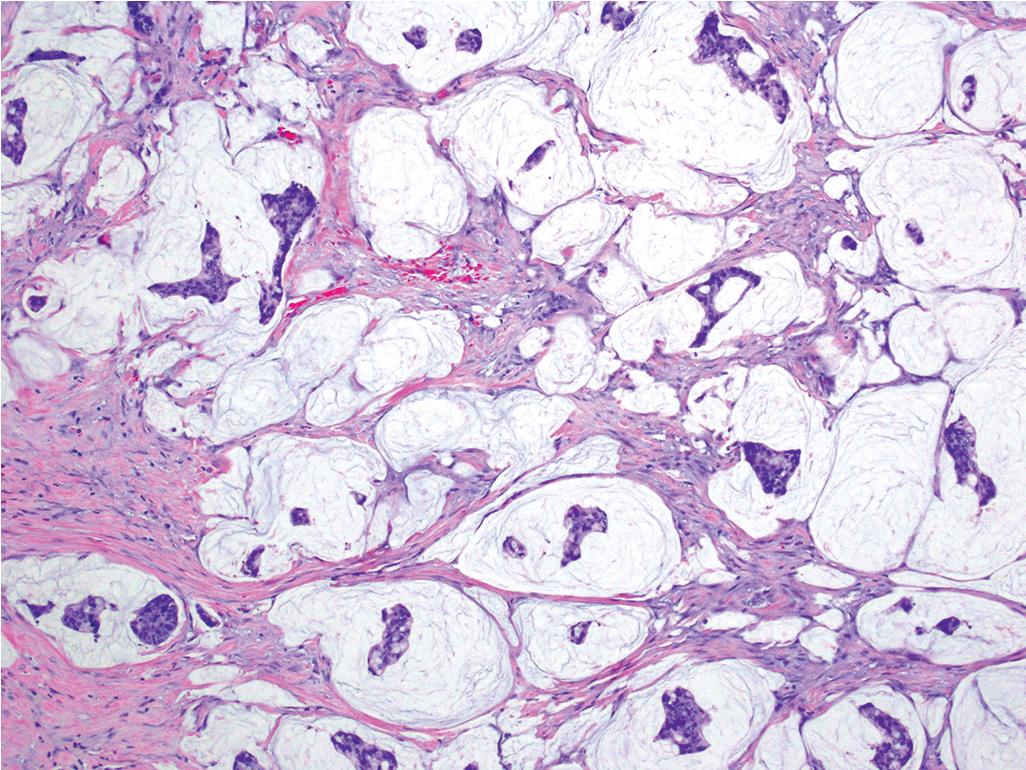
Some patterns of biliary carcinoma lack gland, mucin, or papilla formation. Undifferentiated carcinomas ( Fig. 47.11 ) and sarcomatoid carcinomas represent the least differentiated end of the spectrum of adenocarcinomas, in which glandular differentiation is no longer detectable. These patterns can coexist with conventional adenocarcinomas, pointing to the close relationship of these tumor types. In sarcomatoid carcinomas, the cells acquire mesenchymal characteristics, including a spindle shape; in some cases, “heterologous” elements, such as bone and cartilage, occur. In the absence of a more epithelioid or glandular component or preinvasive neoplasia within the bile ducts, these tumors may be difficult to distinguish from true sarcomas. Some examples of undifferentiated carcinomas are associated with abundant osteoclast-like giant cells and are referred to as undifferentiated carcinoma with osteoclast-like giant cells . It has been well documented that these giant cells are of histiocytic origin, and the malignant cells in this tumor are the mononuclear cells in the background.
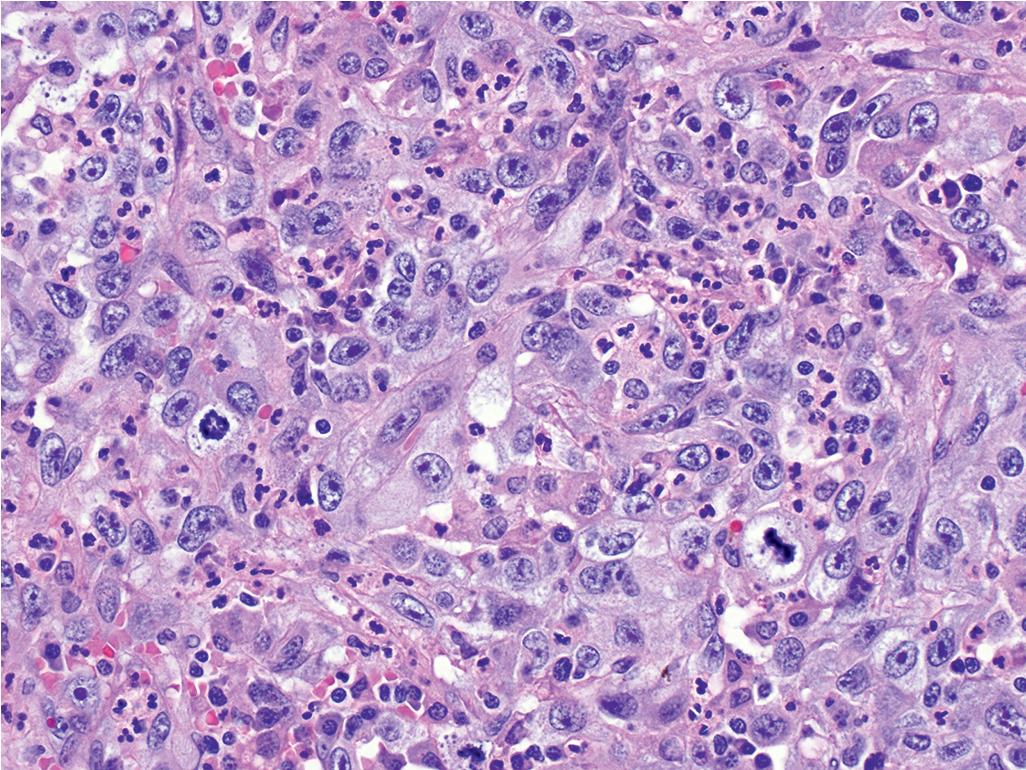
Become a Clinical Tree membership for Full access and enjoy Unlimited articles
If you are a member. Log in here